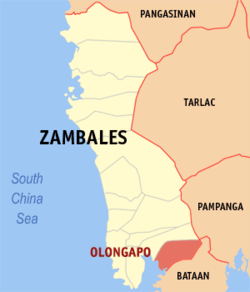Olongapo
| Olongapo | ||
|---|---|---|
| Highly Urbanized City | ||

Ulo ng Apo monument at the Bajac-Bajac rotunda
|
||
|
||
| Nickname(s): City of Volunteers, City of a Thousand Bumble Bees | ||
| Motto: Transparency and Good Governance | ||
| Anthem: Himno ng Olongapo (Hymn of Olongapo) | ||
 Map of Zambales showing the location of Olongapo City |
||
| Location within the Philippines | ||
| Coordinates: 14°50′N 120°17′E / 14.83°N 120.28°ECoordinates: 14°50′N 120°17′E / 14.83°N 120.28°E | ||
| Country | Philippines | |
| Region | Central Luzon (Region III) | |
| Province | Zambales (geographically only) | |
| District | 1st district | |
| Founded | November 4, 1750 | |
| Cityhood | June 1, 1966 | |
| Highly Urbanized City | December 7, 1983 | |
| Barangays | 17 | |
| Government | ||
| • Mayor | Rolen Paulino | |
| • Vice Mayor | Jong Cortez | |
| Area | ||
| • City | 185.00 km2 (71.43 sq mi) | |
| • Metro | 472.16 km2 (182.30 sq mi) | |
| Elevation | 15 m (49 ft) | |
| Population (2015 census) | ||
| • City | 233,040 | |
| • Density | 1,300/km2 (3,300/sq mi) | |
| • Metro | 337,811 | |
| • Metro density | 720/km2 (1,900/sq mi) | |
| Demonym(s) | Olongapeño / Batang Gapo | |
| Time zone | PHT (UTC+8) | |
| ZIP code | 2200 | |
| IDD : area code | +63 (0)47 | |
| Income class | 1st class; highly urbanized | |
| Website | www |
|
Olongapo, officially the City of Olongapo (Ilocano: Ciudad ti Olongapo; Sambali: Syodad nin Olongapo; Filipino: Lungsod ng Olongapo) and often referred to as Olongapo City, is a highly urbanized city in the Philippines. Located in the province of Zambales but governed independently from the province, it has a population of 233,040 people according to the 2015 census. Along with the town/municipality of Subic (and later, Castillejos as well as the municipalities of Dinalupihan, Hermosa and Morong in Bataan), it comprises Metro Olongapo, one of the twelve metropolitan areas in the Philippines.
According to popular legend, there once was a group of warring tribes who lived in the area in and around what is now the modern city. A wise old man (known as apo), seeing the perils of disunity, exerted great effort toward uniting the warring tribes. There were, however, some who bitterly opposed his idea, and one day the old man just disappeared without a trace.
After a long search, the old man's body was found, but with the head missing. It is said that the tribesmen launched search parties to locate the severed head of the man; to the Sambal, decapitation was the only permissible form of assassination.
These efforts proved to be futile, and the search was eventually called off. A young boy, however, vowed to himself that he would not stop searching until he found the elder's head. He searched for weeks, but found nothing. Then, one day, he chanced upon what appeared to be the old man's head, resting on top of a bamboo pole. The boy ran back to his people crying, "Olo nin apo! Olo nin apo!" ("head of the elder" in Sambal; translates as "ulo ng apo" in Tagalog), running hysterically from house to house and village to village. The phrase stuck, and that, according to legend, is how the area got its name, Olongapo.
...
Wikipedia


